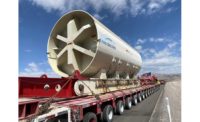The Galena Creek Bridge crosses a wildlife-rich creek and a former Galena mine. (Galena is a natural mineral form of lead sulfide used in batteries). The area is so rural that the job includes 20 miles of 8-ft-tall deer fencing, and crews have reported seeing black bears and mountain lions. Context-sensitive, the bridge has a 689-ft-long center-span arch that visually complements the curves of the neighboring hillsides.
"You want people to notice the bridge as little as possible," says NDOT bridge design engineer Troy Martin. "But when you do notice it, it should be pleasing to look at. It's a balance."
Trouble Brewing
The project went off-balance in 2006 when contractor Edward Kraemer & Sons Inc., Plain, Wis., and NDOT hit an impasse over the Galena Creek Bridge's erection method. The design called for a cast-in-place pilot truss erection method in which 18 steel segments are bolted and welded together, forming a structural framework. The contractor then adds rebar and concrete around the trusses to create the arch. But Kraemer feared the erection of the main span would be unsafe given the area's 80-mph winds. On May 18, 2006, NDOT terminated its $79.5-million contract with Kraemer and both parties walked away, dropping their competing claims.
The project, which had started in December 2003, now was stalled. Kraemer received $50.2 million for work completed, or 63% of its contract, leaving the overall project about 60% complete. While the extension had been scheduled to finish in early 2008, NDOT now needed to find a new contractor. "Our credibility was at stake," Dyson says. "It was imperative that we rise to the challenge."
On Nov. 6, 2006, NDOT awarded Fisher Sand & Gravel Co., Dickinson, N.D., a $393.3-million contract—the single largest contract in the agency's history—to finish the job, although the bid was 19.1% higher than the engineer's estimate. Kiewit Western Co., Concord, Calif., was the runner-up with a $415-million bid. The project drew only two bids due to bonding firms' skittishness over the escalating price tag, officials say. Total freeway costs had grown by $113 million, including Kraemer's payment, from the original estimate. NDOT cut its $130-million annual pavement repair and maintenance program by 50% to pay for the additional expense.
Fearing steep construction inflation, the agency felt pressure to award the project, said NDOT Director Jeffrey Fontaine, who left for another job shortly thereafter. "It would have likely ended up in litigation, and the project was already two years behind schedule. So we decided to make a clean break," he says.
Turning the Page
Fisher and bridge subcontractor C.C. Myers Inc., Rancho Cordova, Calif., also rejected the pilot truss erection method. Instead, they temporarily raised the creek floor elevation by 140 ft using 450,000 cu yd of compacted soil, with a 40-ft-wide, 400-ft-long diversion tunnel to maintain stream flow. Next, they created a 44-ft-dia, 22-ft-tall, 3-ft-thick shotcrete-reinforced temporary bridge arch and custom-fabricated an interior slipform for 40-ft sectional pours. "When you get up that high, there is no other way to do it," Fisher's Nevada manager, Joseph Miller, explains. A $2-million batch plant, using local basalt, was set up on-site. Thirty mixer trucks and a pair of 200-ft-tall pump trucks were used to place concrete.
The most crucial pieces of machinery were computer-controlled strand jacks from Enerpac Integrated Solutions, Butler, Wis. A dozen traveling 85-ton jacks lowered falsework for the pair of 62-ft-wide, three-lane parallel bridge structures. Conventional concrete falsework was too heavy for traditional cables and winches. In contrast, strand jacks uniformly grab, lift and lower cables through hollow centers at a dozen points. Suspended loads averaged 110,000 lb per jack, with lowering speeds of up to 60 ft per hour.


Post a comment to this article
Report Abusive Comment